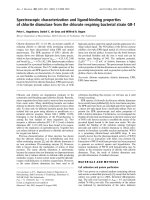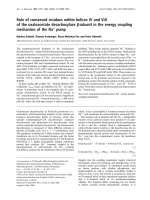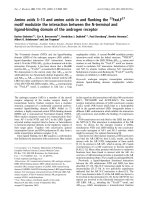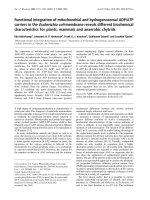Báo cáo y học: " Positive end-expiratory pressure or no positive end-expiratory pressure: is that the question to be asked" docx
Bạn đang xem bản rút gọn của tài liệu. Xem và tải ngay bản đầy đủ của tài liệu tại đây (26.09 KB, 1 trang )
192
PEEP = positive end-expiratory pressure.
Critical Care April 2003 Vol 7 No 2 Villar
Positive end-expiratory pressure (PEEP) is an essential
technique for the respiratory care of many critically ill patients
who require ventilatory support. With the application of PEEP,
the baseline end-expiratory pressure in mechanically ventilated
patients is elevated above atmospheric pressure. In general, the
application of PEEP is expected to improve lung mechanics and
gas exchange as it recruits lung volume in selected patients.
During the past three decades, research on the effects of PEEP
in animal models of acute lung injury and in patients with acute
respiratory failure has produced a plethora of information.
In the present issue of Critical Care Forum, Fernández-
Mondejar and colleagues [1] comment that there is a need
for clinical studies to reassess the value of prophylactic
PEEP. Although numerous approaches to the application of
PEEP have been described, no controlled studies
demonstrating the best method of choosing the level of
PEEP have been published to date.
Although the optimal method of applying PEEP is still
controversial, it is generally agreed that simply using
increased arterial partial pressure of oxygen as the end point
is inappropriate. Although recent reports have supported the
beneficial effects of relatively high levels of PEEP on morbidity
and mortality in patients with acute lung injury, it is still not
clear how much PEEP is required in the ventilatory
management of patients with acute respiratory failure. In
practice, PEEP has been used in the way advocated by Albert
[2]; that is, the lowest level of PEEP that maintains an
adequate arterial partial pressure of oxygen on an inspiratory
fraction of oxygen less than 60%.
In a recent multicenter, observational study, Esteban and
colleagues [3] found that, in general, physicians around the
globe make little effort to define the adequate or optimum level
of PEEP. They found, first, that most physicians applied a
median level of 5 cmH
2
O PEEP, probably reflecting the
commentary by Fernández-Mondejar and colleagues [1].
Esteban and colleagues also found that most physicians are
afraid of applying levels of PEEP > 10 cmH
2
O and, finally, that
one-third of intensive care unit patients were ventilated with zero
PEEP.
If PEEP can markedly improve lung compliance by alveolar
recruitment, why are physicians reluctant to seek the specific
level of PEEP that is best for each individual patient? Ample
experimental and clinical evidence suggests that there is a
wide variability in the adequate level of PEEP in each animal
or patient. Is PEEP different from other therapeutic
maneuvers in the intensive care unit setting? As with other
therapies, and depending on the severity of the patient’s lung
disease, we should titrate the level of PEEP that any patient
requires at any given period during the clinical evolution. In
the same way that there is no a universal dosage of sodium
nitroprussiate to decrease systemic vascular resistance, it
would be difficult to propose a universal level of PEEP for all
patients with respiratory failure. Therefore, it is not whether
we apply or do not apply a ‘prophylactic’ or generic level of
5 or 7 cmH
2
O PEEP what we need to consider. It is the level
of PEEP that each one of our patients requires to reach the
therapeutic goals supported by the best evidence we have.
Competing interests
None declared.
Acknowledgement
Supported, in part, by Fondo de Investigación Sanitaria of Spain
(00/0564).
References
1. Fernández-Mondejar E, Chavero MJ, Machado J: Prophylactic
PEEP: are good intentions enough? Crit Care 2003, 7:191.
2. Albert RK: Least PEEP: primum non nocere. Chest 1985, 87:2-4.
3. Esteban A, Anzueto A, Alia I, Gordo F, Apezteguia C, Palizas F,
Cide D, Goldwaser R, Soto L, Bugedo G, Rodrigo C, Pimentel J,
Raimondi G, Tobin MJ: How is mechanical ventilation
employed in the intensive care unit? Am J Respir Crit Care
Med 2000, 161:1450-1458.
Letter
Positive end-expiratory pressure or no positive end-expiratory
pressure: is that the question to be asked?
Jesús Villar
Director, Research Institute, Hospital NS de Candelaria, Tenerife, Canary Islands, Spain
Correspondence: Dr Jesús Villar,
Published online: 20 January 2003 Critical Care 2003, 7:192 (DOI 10.1186/cc1878)
This article is online at />© 2003 BioMed Central Ltd (Print ISSN 1364-8535; Online ISSN 1466-609X)









